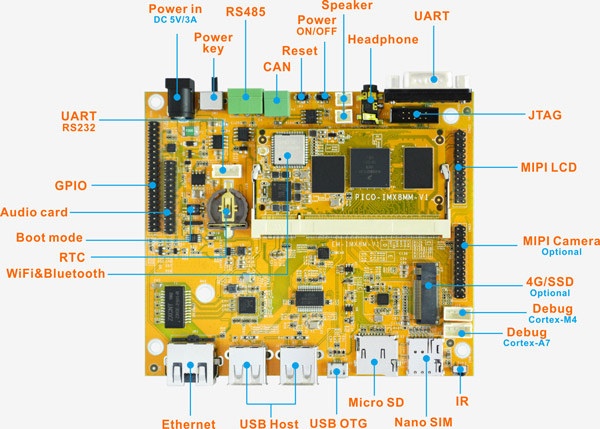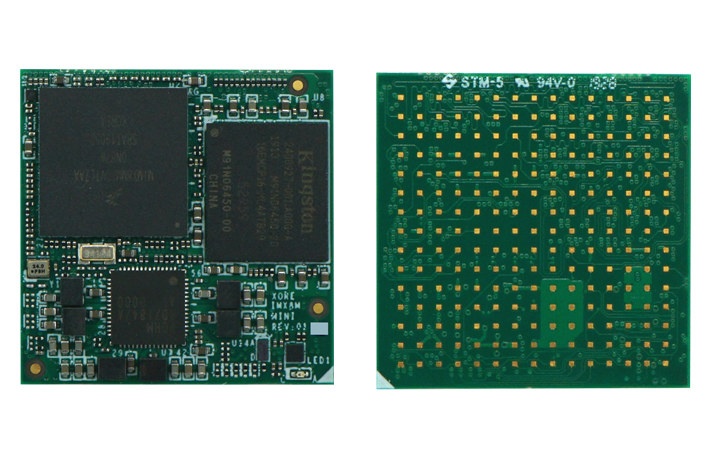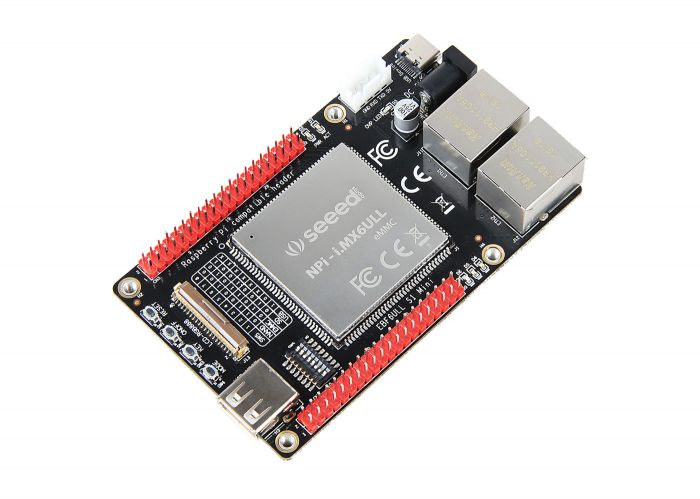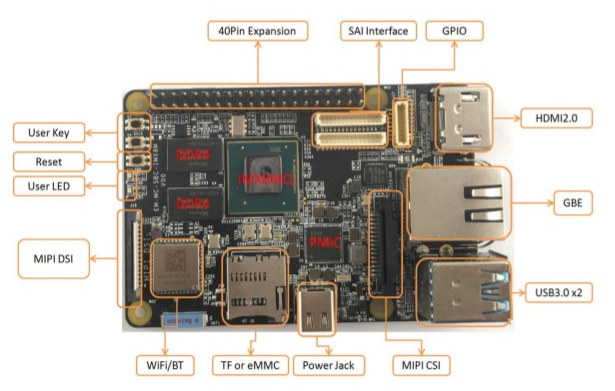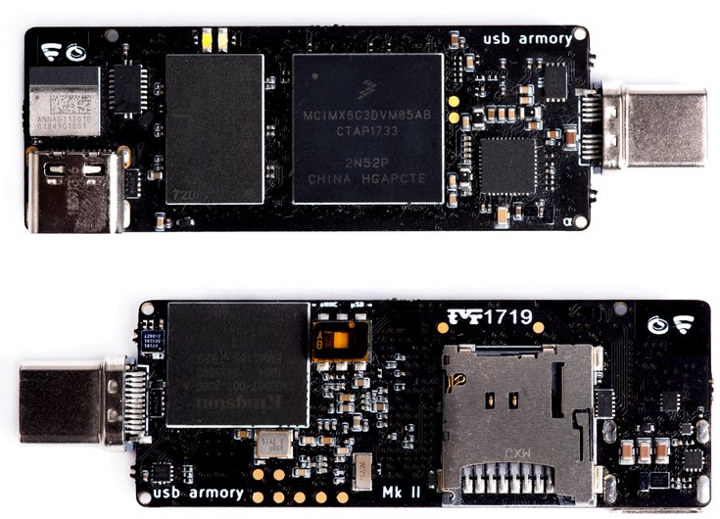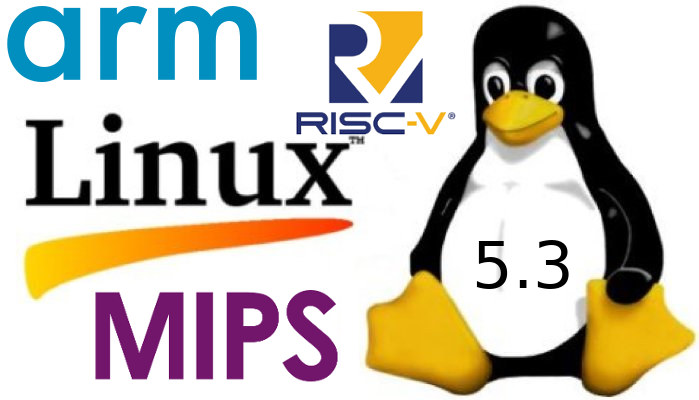We’ve been covered SBC’s and SoM’s from Boardcon for at least 5 years, with our latest article detailing Boardcon Idea3399 SBC powered by Rockchip RK3399 processor, and launched this September. The company has now launched another single board computer with EM-IMX8M-MINI featuring an NXP i.MX 8M Mini system-on-module (SoM) with 2GB LPDDR4, 8GB eMMC flash, and wireless connectivity. The board is designed for a “wide range of multimedia applications” and offers a MIPI DSI interface for LCDs up to 1920×1080 resolution. Boardcon EM-IMX8M-MINI specifications: SOM-IMX8M-MINI SoM (aka PICO-IMX8MM-V1) SoC – NXP i.MX8M Mini Quad with 4x Arm Cortex-A53 @ up to 1.8GHz, Arm an Arm Cortex-M4F real-time microcontroller @ 400MHz, Vivante GCNanoUltra 3D GPU, and Vivante GC320 2D GPU System Memory – 2GB LPDDR4 RAM Storage – 8GB eMMC 5.1 flash, QSPI NOR flash Connectivity – 802.11n WiFi 4 and Bluetooth 4.0 via an Ampak AP6236 module I/Os via 200-pin […]
NXP i.MX RT1170 Arm Cortex-M7/M4 Microcontroller Clocks at One Gigahertz!
Microcontrollers used to be those cute little things that clock at 8 or 16 MHz, but in the last decade, Cortex-M3/M4 microcontrollers became more powerful with 100 to 200 MHz clocks being quite common. But with the introduction of Arm Cortex-M7 core about 5 years ago, microcontrollers are seriously starting to take over tasks that were previously reserved to faster microprocessors. As I remember it, the MCU frequency “race” started with STMicro STM32H7 in 2016 with an impressive 400 MHz, and NXP i.MX RT crossover processor clocked at 600 MHz a few years later. But with i.MX RT1170 microcontroller, NXP has upped the ante as the new MCU combines an Arm Cortex-M4 core clocked at 400MHz with Arm Cortex-M7 core running at an amazing one Gigahertz (1 GHz). The documentation has not been released and we have limited information, but here’s what we know about NXP i.MX RT1170 key features […]
TechNexion XORE is a tiny NXP i.MX 8M Mini LGA System-on-Module
There are several ways to design a system-on-module to carrier board interface, and the most common solutions are edge connectors (e.g. SO-DIMM), board-to-board connectors (placed under the module), and castellated holes where the board is soldered directly to the baseboard. Another less common method is to design an LGA (Land Grid Array) module, which also have to be soldered straight unto the carrier board, but enables much more compact system-on-modules, and that’s exacty what TechNexion has done with their XORE family of LGA system-on-module currently powered by the 14-nm NXP i.MX 8M Mini processor. XORE-IMX8M-Mini Module TechNexion XORE module specifications: SoC (one of the other) NXP i.MX8M Mini Solo single Arm Cortex-A53 @ 1.8 GHz + M4 processor, Vivante GC7000Lite 3D GPU NXP i.MX8M Mini Dual 2x Arm Cortex-A53 @ 1.8 GHz + M4 processor, Vivante GC7000Lite 3D GPU NXP i.MX8M Mini Quad 4x Arm Cortex-A53 @ 1.8 GHz + M4 […]
NPi i.MX6ULL (Not So) Industrial-grade Linux SBC Starts at $39
[Update: I was initially informed the temperature range of the board was -40°C to +105°C, but Seeed Studio issues a correction explaining the Core module itself is rated -20℃ ~ 80℃ temperature range, and they haven’t tested the breakout board at all so we just don’t know. That means the board is not industrial-grade at all. I’ve left the rest of the post mostly unchanged] We’ve covered several NXP i.MX boards in recent days, but here’s another NXP board courtesy of Seeed Studio with NPi i.MX6ULL industrial-grade Linux SBC powered by a low power NXP i.MX6ULL Arm Cortex A7 processor. The board also comes with 512MB RAM, either an 8GB eMMC flash or 256MB NAND flash for storage, features two Fast Ethernet ports, and various I/Os including two 40-pin GPIO expansion headers. NPi i.MX6ULL board specifications: Core Module SoC – NXP MCIMX6Y2CVM08AB single Cortex-A7 core @ up to 800 MHz […]
MaaXBoard NXP i.MX 8M Raspberry Pi Compatible Board Runs Android 9.0 or Yocto Linux
When we looked for information about PICO-PI-IMX8M single board computer, we noticed another Raspberry Pi shaped board powered by NXP i.MX 8M processor: MaaXBoard by Embest, an AVNET company. The board comes with up to 4 GB DDR4 RAM, a MicroSD card slot or eMMC flash for storage, Gigabit Ethernet, WiFi & Bluetooth, HDMI 2.0, USB 3.0 port, MIPI CSI & DSI ports, and of course a the 40-pin “Raspberry Pi” expansion header. MaaxBoard specifications: SoC – NXP i.MX 8MQ quad-core Arm Cortex-A53 processor, Cortex-M4F real-time core, and Vivante GPU with OpenGL/ES 3.1, OpenGL 3.0, Vulkan, OpenCL 1.2 System Memory – 2GB DDR4 SDRAM (up to 4GB) Storage – MicroSD card slot or optional eMMC flash up to 64GB Video Output – HDMI 2.0 up to 4K @ 60 Hz, MIPI DSI display connector Video Playback – 4Kp60 with High Dynamic Range (H.265, VP9), 4Kp30 (H.264), 1080p60 (MPEG2, MPEG4p2, VC1, […]
WandPi 8M SBC Comes Back as PICO-PI-IMX8M with SoM & Raspberry Pi Compatible Baseboard
Back in 2017, WandBoard announced the release of an upcoming Raspberry Pi like SBC based around the NXP i.MX8M Quad applications processor, ARM Cortex-A53 + M4 architecture and Vivante GC7000 GPU called the WandPi 8M. The board was designed around the popular Pi (85 x 56 mm) form factor bringing 4K UltraHD with HDR video quality with pro audio fidelity. WandPi 8M was scheduled for the release in spring of 2018, but ever since WandPi 8M never came to life. It was suggested that the board must have gone to the SBC heaven. Back to 2019, a similar board was discovered recently on Hacker boards called the PICO-PI-IMX8M with almost similar design and specification. The PICO-PI-IMX8M board shown also features the same NXP i.MX8M Quad-core processor and the Vivante GC7000 GPU but relies on PICO-IMX8M system-on-module plus a baseboard inspired by Raspberry Pi form factor, and compatible with (most) HAT […]
USB Armory Mk II USB Linux Computer Targets Security Applications (Crowdfunding)
Back in 2014, Inverse Path launched USB Armory computer dongle running headless Linux from a MicroSD card and designed for security applications. The company got bought by F-Secure Foundry in 2017, and the latter has now launched another crowdfunding campaign for an upgraded version USB Armory Mk II keeps a similar USB dongle form factor but replaces the NXP i.MX53 Cortex-A8 processor with a more efficiency NXP i.MX 6ULZ Arm Cortex-A7 processor, the USB type-A port with a modern USB-C port, adds 16GB eMMC flash, Bluetooth 5 LE connectivity, and new security features. USB Armory Mk II specifications: SoC – NXP i.MX6ULZ Arm Cortex-A7 @ 900 MHz System Memory – 512 MB DDR3 RAM Storage – 16 GB eMMC flash + external microSD Connectivity – Bluetooth 5 LE + mesh module (U-blox ANNA-B112) with Arm Cortex-M4 MCU (nRF52832) USB – 2x USB type-C ports: 1x DRP (Dual Role Power) receptacle […]
Linux 5.3 Release – Main Changes, Arm, MIPS & RISC-V Architectures
Linus Torvalds has just announced the release of Linux 5.3: So we’ve had a fairly quiet last week, but I think it was good that we ended up having that extra week and the final rc8. Even if the reason for that extra week was my travel schedule rather than any pending issues, we ended up having a few good fixes come in, including some for some bad btrfs behavior. Yeah, there’s some unnecessary noise in there too (like the speling fixes), but we also had several last-minute reverts for things that caused issues. One _particularly_ last-minute revert is the top-most commit (ignoring the version change itself) done just before the release, and while it’s very annoying, it’s perhaps also instructive. What’s instructive about it is that I reverted a commit that wasn’t actually buggy. In fact, it was doing exactly what it set out to do, and did it […]


